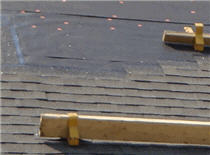
The Cost of Roof and Estimates
Make no mistake, having a roof replaced or a new one installed is among
the costlier of projects to undertake. Several factors help to determine
the total price incurred, not the least of which is contractor-dependent.
Your location will also influence the estimates that you receive.
Majors price quote variations are attributable to the design, the type
of shingles being put down, and a host of factors.
With few exceptions, the roof design is the
single greatest factor affecting price - it determines the amount of labor that is spent and
to some extent the type of roof material that is chosen.
Costing by Materials & Roof Design
The gable style roof is among the cheapest roofing job
to have done, in asphalt shingles. These ranch-style homes or other structures
made of straight open sections are easy to access and completed relatively quick.
Calling in a roofing firm for a shallow pitch, 1500 to 1900 square foot roof
can price out in the range of $1200 to $1500 and perhaps under for another
layer being added. While a whole tear-off, depending on the grade and types of
shingles and materials, like ventilation and metalwork, can run
in excess of $1,850 and greater.
Given that other materials are on option and that they are compatible
with an existing roof - using tiles like ceramic, metal or concrete tiles - appealing
as they are, will easily add 20% to 25% more to the paid amount.
Wood shingles and shakes for a 1500 to 1900 sq ft roof can run in the neighborhood
of $6,100 to $15,000.
Figuring metal roofing is not so straightforward, since the panels are available
in so many options, from metal and aluminum to standing seam and ribbed panel systems.
Though they do offer fire resistant and certain long term benefits.
Designs that account for higher prices are the gambrel style, given its
multiple ridges, and mansards. As well as steeple
structures ('witches hat') found on aged structures - that require that
staging be set and advanced methods, with slate at $45 to $50 per foot and
on up, composition and tiles normally get considered.
Other Estimating Factors
In reality, tallying total amounts charged for roofing is contingent on many factors, including:
Hip & Valley Sections - recognizable as the 'L' shape,
these do act to raise costs since these much break the straight
run (and are subject to moisture infiltration).
Patterns - that specify what pattern the roof is be applied. Make sure you are paying for the
exposure you prefer.
This could be 5" or 6" amount for shingles priced accordingly.
Dormers - that in essence are treated seperate, creating their own valleys.
Working Height - whether it is first story, second story or 3rd level,
efforts go up considerably because not only is there greater risk,
the logistics of heavy shingles must be placed by automatic means.
Tip: If doing the roof yourself - secure rooftop delivery.
Warrantees - which should be in writing. Take a closer view of the makeup, and
even if the labor is guaranteed. In the event of failure who covers costs?
Shingle manufactures have a tendency to specify materials over the years pro-rata.

